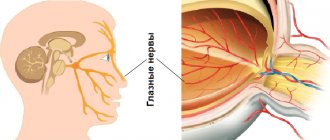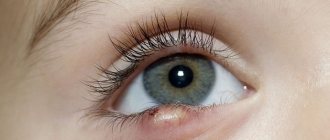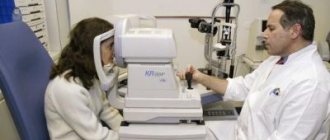Anatomical structure
The eyelids are an auxiliary component in the visual apparatus. Their main task is to protect the eyeball. The function is associated with protecting the mucous membrane from irritation and exposure to external factors. They regulate the lighting and its direction.
Main functions of the eyelids:
- the blinking process, which enhances the functioning of the lacrimal gland and allows hydration to be distributed throughout the membrane;
- protection from damage and injury;
- ensures the direction of tears into the conjunctiva and lacrimal sac.
The anatomical structure of the eyelids consists of skin, subcutaneous tissue, conjunctiva, muscle and axillary tissue. Each part plays an important role in blinking. If you start learning about anatomy, you should remember the sagittal cross-section of the eyelids. Different levels of study help determine the exact number of layers of the eyelids and their interaction.
The orbital septum is the anatomical boundary between the tissue of the eye and the eyelids. The anatomical structure is very important during surgical treatment. Before performing eyelid reconstruction, the physician will determine the choice of anterior or posterior plate. In anatomy, the anterior plate is the skin, and the posterior plate is the conjunctiva. Each of them has an important function and is subject to the development of different diseases.
Functions
The most important physiological role of the eyelids is a protective function. Without eyelids, eyes could not be healthy and fully fulfill their purpose. Eyelids and eyelashes are needed to protect the mucous membrane from small particles. In order for it to be performed correctly, the following mechanisms will need to work:
- Eyelashes trap small particles that are in the environment. They brush them away from the mucous membrane while blinking. This is a very important protection.
- Provides hydration of the mucous membrane. This helps get rid of small specks of dust that get into your eyes. In this way, specks and small particles come out on their own.
- The blinking process is necessary to cleanse the surface of the mucosa from foreign particles.
- When the eyelids are closed during sleep, it prevents the eyeballs from drying out. In addition, they provide protection against the ingress of foreign objects. Closing the eye in a timely manner prevents injury and damage.
- Any disease of the eyelids leads to disruption of the protective function. This can cause other ophthalmological diseases, infectious and bacterial damage.
The protective function is very important. The mucous membrane of the eye is sensitive to external irritants. Therefore, there is a risk of developing pathological processes and inflammation. They can be prevented by proper care of the skin of the eyelids and eyelashes. It is not recommended to use cheap cosmetics. You should also give up smoking and other bad habits.
Preventive measures will help prevent the development of pathologies.
Barley
Staphylococcus aureus under a microscope
Barley is an infectious disease in which inflammation of the ciliary follicles or meibomian glands occurs. It first appears as a small lump, on which a head forms after a few days. The causative agent of this disease is usually Staphylococcus aureus, an opportunistic microorganism.
Barley has two types: internal and external. If the eyelash follicle becomes inflamed, an external stye is formed. In case of inflammation of the meibomian gland - internal barley. To find out whether stye is contagious and how it is transmitted, be sure to read the article on this topic, which you will find directly on our website.
Symptoms of stye
Typical symptoms of stye include:
- sensation of a foreign body in the eye;
- redness;
- severe pain syndrome;
- swelling of the eyelids;
- temperature rise is possible.
The lump with barley is very painful and adheres to the skin. When barley ripens, a purulent head forms, after which the barley opens on its own.
The main thing you should not do is try to crush or pierce the stye, especially on your own.
Treatment of barley
Usually such a seal on the eye is treated with medication:
- Antibacterial eye drops are used. These include: albucid, levomecitin, tobrex. To learn more about drops against stye and how to use them correctly, be sure to read the article about drops against stye on our website.
- Use antimicrobial ointments. They are most often applied at night: tetracycline, erythromycin ointments. Find out a lot more about antibacterial ointments against stye here.
- Antiseptic solutions are used to wash the eyes: chlorgrexedine, miramistin.
Without treatment, barley ripens within 7-10 days, with treatment 3-4.
As a rule, barley affects one eye and the inflammation rarely spreads to the second, but for the purpose of prevention, antibacterial drops should be instilled into both eyes.
Be sure to read a separate section on how to treat stye, which you will find right here on the website. We also recommend reading the article about quick treatment of stye at home.
Diseases of the eyelids
Diseases of the eyelids can be associated with bacterial, viral, or infectious lesions. Each of them has characteristic symptoms and treatment methods. The following diseases mainly occur:
- stye (mainly affects the lower eyelid);
- blepharitis;
- ptosis;
- abscess;
- phlegmon.
Each disease should be considered in detail. If there are suspicious signs, you should consult a doctor. The lack of a protective function can cause severe ophthalmological diseases. Lack of therapy leads to irreversible processes. Diagnosis is carried out using visual inspection and special instruments. After determining the etiology of the disease, the doctor can prescribe adequate treatment.
| Name of the disease | Etiology | Symptoms | Description |
| Ptosis | The congenital form may occur due to improper development or absence of the muscles that are responsible for raising the upper eyelid. This may be associated with pathologies of intrauterine development due to genetic diseases. The acquired form occurs due to injuries, diseases of the central nervous system, and muscle pathologies. Children experience ptosis due to trauma during childbirth. | excessive raising of the head; forehead wrinkling; the head bends to one side; discomfort; decreased visual acuity; painful sensations. | Accompanied by drooping of the upper eyelid. It can be expressed slightly or completely close the eye. It has acquired and congenital forms. A serious consequence is loss of vision and strabismus. Treatment is intended to restore the function of the damaged nerve. For this, conservative therapy is prescribed. You can do facial exercises on your own. |
| Maymobit | The reason for the development may be hidden in: bacterial infection, especially staphylococcus, hypothermia, ARVI, poor hygiene, unhealthy lifestyle, eye injuries. | redness; pain; inflammation, swelling; thickening of the eyelids; itching; yellowing of the inner edges of the eyelids; increased lacrimation. | This disease is accompanied by inflammation of the cartilage of the eyelids. The purulent process has acute and chronic forms. Antibacterial and antiseptic drugs are prescribed for treatment. If pustules appear, they are treated with a disinfectant solution. |
| Dermatitis | Dermatitis appears due to the presence of an allergic reaction, autoimmune and infectious diseases, and digestive disorders. | redness, itching; inflammation; dryness and flaking of the skin; severe swelling; rash in the form of blisters; deterioration of health. It is worth considering that the initial symptoms are similar to ARVI. | This causes inflammation of the eyelids. The skin is sensitive and vulnerable, so inflammation can cause premature aging of the eyelids. Exacerbation is accompanied by pronounced manifestations. If you have dermatitis, it is forbidden to use cosmetic products. Furacilin, antihistamines and sorbents are used for treatment. |
| "Hanging eyelid" | The reasons may lie in: anatomical structure, age-related changes, excessive stress, an allergic reaction, sudden weight loss. This is also affected by the presence of bad habits. | Apart from a visual defect, it is not accompanied by other symptoms. May cause discomfort in humans. | This is a pathological process that has a congenital or acquired form. Appears in patients of different age categories. It can only be eliminated with plastic surgery. |
In some cases, surgical treatment is the only option. In medicine, eyelid surgery is called “blepharoplasty”. To achieve quick and effective results, it is recommended to do the following cosmetic procedures:
- lifting using collagen – applying collagen has a tightening effect (the procedure is one of the safest and most effective);
- the use of microcurrent therapy - this method helps to tighten the eyelid and accelerate regenerative processes;
- lymphatic drainage – used to obtain tone and eliminate it.
Women can hide the presence of a defect with the right makeup. The idea is to apply it with your eyes open. But this only helps with slight overhang. It is worth considering that the development of the “impending” eyelid, which progresses, requires examination by an ophthalmologist.
This may be a sign of the development of serious illnesses.
Treatment of pathological processes caused by infectious, bacterial, viral lesions is possible using conservative methods. It is important to follow the rules of hygiene and properly care for your eyelids and eyelashes. During the treatment period, it is prohibited to use cosmetic products. They can cause secondary infection and inflammation. Medicines are used after a doctor's prescription.
century
CENTURY, a, about a century, for a century, pl. a, ov, m.
1. A period of one hundred years, conventionally calculated from the birth of Jesus Christ (Christmas). Third century BC. Twentieth century (period from January 1, 1901 to December 31, 2000). Beginning of the century (tenth twenties). Mid in. (fifties). End in. (eighties and nineties). First half of the century (until the fifties). Second half of the century (after the fifties). Towards the twenty-first century. Event (discovery, discovery, crime, murder, scandal) of the century (the most significant, loudest of all similar ones for a whole century). The Middle Ages (in the history of different countries: a period coinciding with the era of feudalism).
2. The term is one hundred years. The old man lived for almost... (almost a hundred years). The museum is more than two centuries old.
3. what or which. Historical period, era characterized by (from the industrial, scientific, social side). Knightly centuries. V. enlightenment. Stone v. (a period of primitive culture characterized by the production of tools and weapons from stone and bone). Bronze c. (a period of ancient culture characterized by the production of tools and weapons made of bronze). Iron v. (a period of ancient culture characterized by the production of tools and weapons made of iron). Golden in. (the heyday of the arts and sciences). Space in. (the period of study and exploration of space and extraterrestrial objects).
4. century, century. A very long time, eternity. It’s not a long time to wait for you. A whole century of waiting for letters. Century sits at home. This day seemed like a century to him.
5. units; genus. a(y), usually with a definition. life (in 3 digits), chyon. existence. In my lifetime (during my long lifetime) I have seen a lot. Live out your life in. Nedolog v. moth. V. horse is 20 years old. God did not give a century (century) to communes. (about early death).
• In the centuries (to become famous, to live) (high) to become famous for all times. The glory of heroes lives on for centuries.
Forever and ever (obsolete and high) forever, always.
For centuries (high) forever.
For ever and ever and ever and ever (high) forever.
Until the end of time (obsolete high) until the end of life.
With the century, keeping up with modern times.
In step with the century (walk, walk) is the same as with the century on a par.
Live forever, learn forever. that there are no limits to learning and knowledge. Live forever, learn, die a fool (last).
From time immemorial (colloquial) from ancient times, from time immemorial. This is how it has been for centuries.
From time immemorial (bookish) the same as from time immemorial.
From time immemorial, from time immemorial (y) (colloquial) the same as from time immemorial.
In koi (koi) eyelids (colloquial) very rarely. For once, visit.
| adj. century-old, aya, oe (to 1 meaning).











